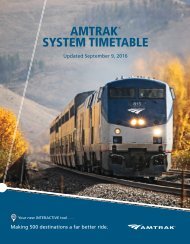Queens
northeast_queens_bus_study_-_final_9-28-15
northeast_queens_bus_study_-_final_9-28-15
You also want an ePaper? Increase the reach of your titles
YUMPU automatically turns print PDFs into web optimized ePapers that Google loves.
, Metropolitan Transportation Authority<br />
Methodology<br />
This study evaluates current bus service in Northeast <strong>Queens</strong> using various sources of data and community<br />
input. These data primarily include Bus Time GPS data and Automatic Fare Collection MetroCard data.<br />
This study examined a large amount of archived Bus Time data, integrated with Automatic Fare Collection<br />
(AFC) data from MetroCards. The data were captured and analyzed to evaluate bus service, performance,<br />
and ridership. This methodology provided service planners with a comprehensive dataset based on 100%<br />
of actual data.<br />
Since the launch of Bus Time for <strong>Queens</strong> buses in 2014, real time automatic vehicle location information<br />
is available for all buses. These data are captured and stored to evaluate bus service, performance, and<br />
ridership, supplementing the prior system of manual data sampling with traffic counts. With the data<br />
captured from Bus Time, wait assessment and on‐time performance data are calculated. These metrics,<br />
along with service availability and passenger environment scores, were evaluated to determine quality of<br />
service. Automatic Fare Collection MetroCard data provided ridership and transfer information.<br />
Community input was received at meetings of the Public Transit/Transportation Committees of <strong>Queens</strong><br />
Community Boards 7, 8, 11, and 13 between October 2014 and April 2015, as well as a public workshop<br />
held on February 26, 2015 at <strong>Queens</strong>borough Community College. More than 100 participants attended<br />
the Northeast <strong>Queens</strong> Bus Study Public Workshop. This provided an opportunity for community residents<br />
to speak directly to bus service planners about bus service in the area. Further comments were collected<br />
by the office of Senator Avella and forwarded to the MTA for consideration and analysis.<br />
Characteristics of Northeast <strong>Queens</strong><br />
Northeast <strong>Queens</strong> is a large area that covers 31 square miles. The study area is bounded by Flushing Bay<br />
and the Van Wyck Expressway to the west, Hillside Avenue to the south, the Nassau County line to the<br />
east, and the East River to the north.<br />
This study area is composed of the following neighborhoods: Flushing, Whitestone, Bay Terrace, Bayside,<br />
College Point, Oakland Gardens, Douglaston, Glen Oaks, Fresh Meadows, Little Neck, Mitchell‐Linden,<br />
Bowne Park, Beechhurst, Bellerose, Fort Totten, Malba, Robinwood, Auburndale, Floral Park, Hollis Hills,<br />
<strong>Queens</strong> Village, and New Hyde Park in addition to others. Northeast <strong>Queens</strong> spans Community Boards<br />
7,8,11, and 13. Downtown Flushing is the major economic center and transportation hub within the area.<br />
Major educational institutions include <strong>Queens</strong> College, St. Johns University, and <strong>Queens</strong>borough<br />
Community College. There are also several large high schools within the study area. Schools are one of<br />
the largest generators of bus customers in Northeast <strong>Queens</strong>. Other community facilities and parks in the<br />
study area include <strong>Queens</strong> Botanical Garden, Kissena Park, <strong>Queens</strong> County Farm Museum and Alley Pond<br />
Park. Large institutions such as the NY Hospital Center of <strong>Queens</strong>, Long Island Jewish Hospital, Creedmoor<br />
State Hospital, and Flushing Hospital are also located in the area.<br />
4



